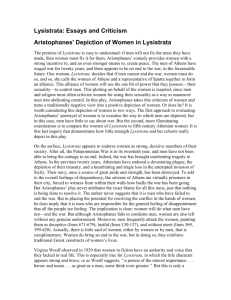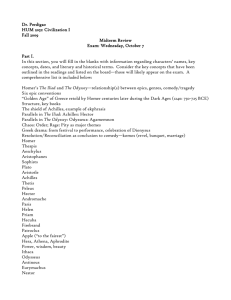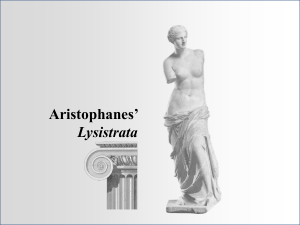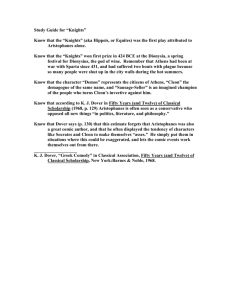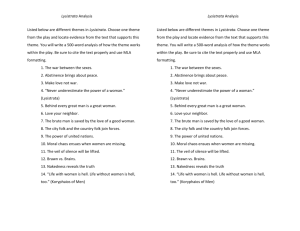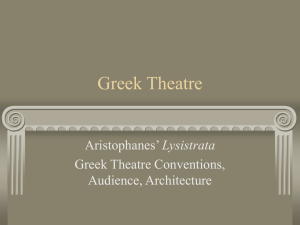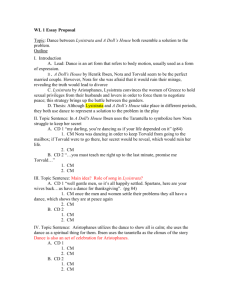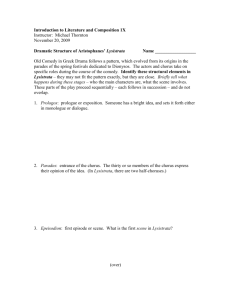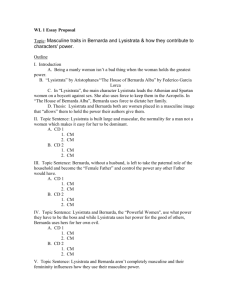Feminist Literary Criticism and Lysistrata
advertisement
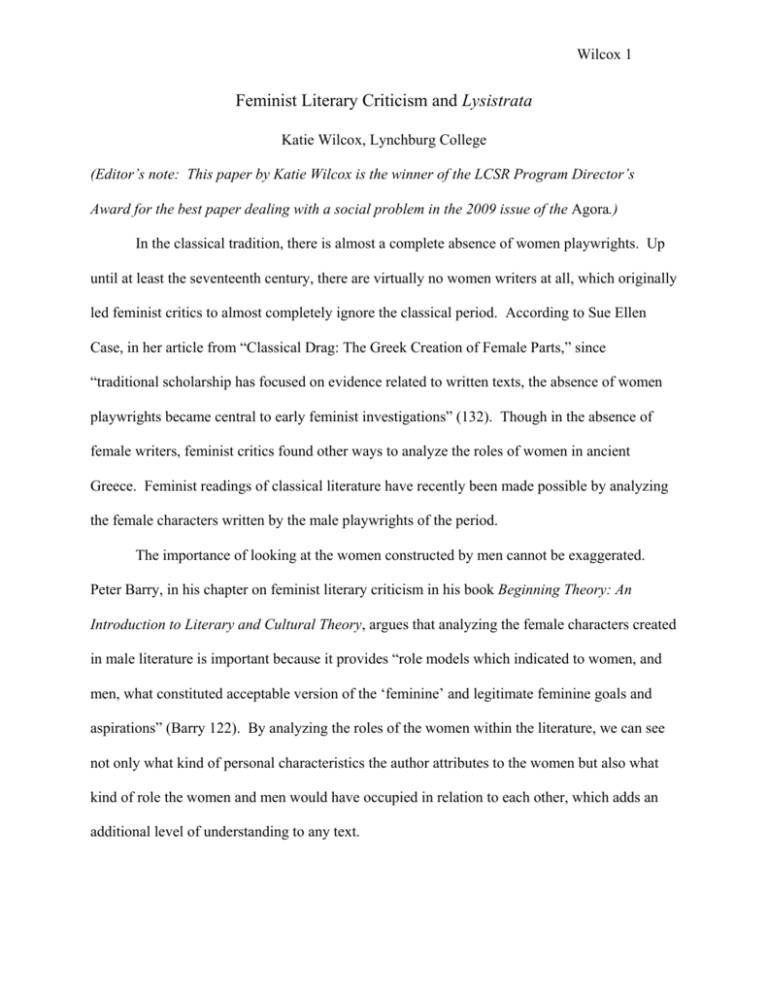
Wilcox 1 Feminist Literary Criticism and Lysistrata Katie Wilcox, Lynchburg College (Editor’s note: This paper by Katie Wilcox is the winner of the LCSR Program Director’s Award for the best paper dealing with a social problem in the 2009 issue of the Agora.) In the classical tradition, there is almost a complete absence of women playwrights. Up until at least the seventeenth century, there are virtually no women writers at all, which originally led feminist critics to almost completely ignore the classical period. According to Sue Ellen Case, in her article from “Classical Drag: The Greek Creation of Female Parts,” since “traditional scholarship has focused on evidence related to written texts, the absence of women playwrights became central to early feminist investigations” (132). Though in the absence of female writers, feminist critics found other ways to analyze the roles of women in ancient Greece. Feminist readings of classical literature have recently been made possible by analyzing the female characters written by the male playwrights of the period. The importance of looking at the women constructed by men cannot be exaggerated. Peter Barry, in his chapter on feminist literary criticism in his book Beginning Theory: An Introduction to Literary and Cultural Theory, argues that analyzing the female characters created in male literature is important because it provides “role models which indicated to women, and men, what constituted acceptable version of the ‘feminine’ and legitimate feminine goals and aspirations” (Barry 122). By analyzing the roles of the women within the literature, we can see not only what kind of personal characteristics the author attributes to the women but also what kind of role the women and men would have occupied in relation to each other, which adds an additional level of understanding to any text. Wilcox 2 This approach is distinctly different from analyzing women created by other women because, according to the feminist critic, the women who are created by men primarily represent stereotypes or generalization of actual women. That is, “the feminist critic may assume that the images of women in these plays represent a fiction of women constructed by the patriarchy” (Case 132). These women, in other words, are not actual women, but are instead versions of women created by men to be what men think women actually are, and by analyzing the roles in which men place those fictional women, we can examine the “cultural ‘mind-set’ in men and women which perpetuates cultural inequality” (Barry 122). Obviously, this representation of women is what most concerns feminist literary critics. Women characters in classical drama, like Aristophanes’ Lysistrata, are not so much realistic, well-rounded female characters, but figments of a classical male imagination. The patriarchal representations of the women in Lysistrata are made unrealistic in terms of their behavior towards one another and the relative amount of power that they gain through their attempt to influence the diplomacy of the men, but the societal constraints on their behavior are relatively accurate. Women in ancient Greek society, particularly in Athens, had little to no political or social influence. Originally, they took part in the traditional religious practices, like the festivals of the god Dionysus. “In the sixth century, both women and men participated in these ceremonies, but by the fifth century, when ceremonies were becoming what is known as theatre, women disappeared from the practice” (Case 133). The reason women’s involvement declined around this period was not the result of any regulations of law that excluded them, but rather the prevalence of emerging ideas of appropriate social conduct and morality. The idea of excluding women was a practice taken from the Ionians, who “inaugurated the exclusion of women from Wilcox 3 the public sphere and their confinement to the home and to the company of female friends” (Katz 72). A rise in the importance of women’s role coincided with the rise of the family unit. “Ironically, the important role women began to assume within the family unit was the cause of their removal from public life” (Case 133). Prostitution, also borrowed from the Ionians, became widespread as women who desired the ability to act against their husbands’ limitless power secluded themselves. Men increasingly sought the company of hetairas (female companions), whom the men generally loved and respected for their independence and education, while “the housewife was little esteemed and loved” (Katz 73). Around the same time, exchange of metals and accumulation of wealth within the sphere of the individual family became more widespread. Personal wealth, though, was not concentrated in the hands of women. Instead, women became part of the means of exchange through the institution of marriage, rather than equal sharers in the wealth. “In fact, the word for marriage, ekdosis, meant loan—women were loaned to their husbands by their fathers, and in the case of a divorce, they were returned to their fathers” (Case 133). The system of marriage further reduced the significance of women in society. Because women were unable to hold property or exist as individuals in their own right, their importance as people was almost entirely limited to the domestic arena. Case suggests that classical literature has tended to represent women in two basic ways, which necessarily “reflect the perspective of the playwright or of the theatrical tradition on women” (132). There are (1) “positive roles, which depict women as independent, intelligent and even heroic and (2) a surplus of misogynistic roles commonly identified as the Bitch, the Witch, the Vamp or the Virgin/Goddess” (Case 132). In Lysistrata, the main characters, Lysistrata, Kalonike, and Myrrhina are characterized as the former. Lysistrata, the main character, comes up with a scheme that the women of Greece should give up sex with their Wilcox 4 husbands in an attempt to force them to make a peace treaty to end the Peloponnesian War. She boldly encourages all of the women from all of the city-states of Greece to join with her to do their part to end the war, which lasted for nearly thirty years (Holladay 54). “Yet if all the women meet us here as I told them to from Sparta, Thebes and all of their allies, and we of Athens, all together we’ll save Greece,” (Aristophanes 39-41) she says, encouraging them to refuse sex with their husbands. She tells them that soon the men will be so frustrated with their desire that they will be eager to do everything in their power to make peace diplomatically rather than militarily. “I’m absolutely sure,” she says, “if we should sit around, rouged and with skins all creamed, with nothing on but a transparent negligee, and come up to them with our deltas plucked quite smooth, and, once our men get stiff and come to grips, we do not yield to them at all, but just hold off, they’ll make a truce in no time” (Aristophanes 147-154). Her self-assured speech resonates with her belief in female power. Kalonike, although she is initially hesitant to give up sex, eventually agrees to Lysistrata’s scheme and is the first to take the oath: No lover and no husband and no man on earth— shall e’er approach me with his penis up and I shall lead an unlaid life at home, wearing saffron gown and groomed and beautified so that my husband will be all on fire for me but I will never willingly give in to him and if he tries to force me to against my will I’ll do it badly and not wiggle in response nor toward the ceiling will I lift my Persian pumps nor couch as the lion on cheese-graters do and if I keep my promise may I drink of this— but if I break it, then may water fill the cup! (Aristophanes 214-237). Myrrhina, another one of the Athenian women, also uses the power of her sexuality to control her husband. She teases him when he thinks that they are finally about to have sex. Running back and forth, she keeps bringing things out that they need in order to deter him from his goal and further her own. “Wait here,” she says, “and I’ll go get a cot for us” (Aristophanes 1018). Wilcox 5 She returns and they resume, briefly, and she interjects with another objection. “Oh, what a nuisance! I must go and get a mat,” (Aristophanes 1023)! When she finally returns, they resume again, and she says, “Oh, what a nuisance, you don’t have a pillow, dear,” (Aristophanes 1026) and when he insists that he does not need a pillow, she replies, “Oh, but I do” (Aristophanes 1027). She keeps stalling, all the while reminding him, “Now don’t forget: about that treaty— you won’t disappoint me, dear?” (Aristophanes 1030-1031) and “But dearest, don’t forget you’re going to vote for peace” (Aristophanes 1052). In all of these cases, the major women in the play are extremely strong-willed individuals who will stop at nothing, even harnessing the power of their own sexuality, in order to promote peace between the city states of Greece, which places them in the first of Case’s categories of female representation. Faraone, on the other hand, divides the women in Lysistrata into two distinct groups: the younger, sexually active married women, and the older women who are members of the female chorus. The younger women “appear foolish and are easily manipulated by their bodily desires, especially the desire for sex and wine” (39). These women are drawn in stark contrast to the older women, who are portrayed in a much more positive light: “They pray earnestly to the gods, boast their service in the cults of the city,” and are engaged in classic female work, carrying water, which, “has numerous echoes in popular myths and rituals concerned with salvation” (39). Regardless of the way they are portrayed, though, Faraone argues that Aristophanes still portrays, with both kinds of female characters, a certain kind of feminine heroism. Despite the existence of these undoubtedly strong female characters, other evidence points to the idea that these women had very little actual influence in the ancient world. In a world where men dominated the political sphere and women could exert only limited control over the domestic sphere, sex is a very domestic concern. The women, in order to influence the Wilcox 6 men in the way that they desired, had to resort to the use of their sexuality, rather than using their brains or any available political channels. Lysistrata argues the unique position of power that the women occupy, saying, “But only the spirit of tender Love, and the power of sweet Aphrodite were to breathe down over our breasts and thighs an attraction both melting and mighty, and infuse a pleasanter rigor in men, raising on their cudgels of passion, then I think we’d be known throughout all of Greece as makers of peace and good fashion” (Aristophanes 604-610). This reference at the end of her speech to the “fashion” of their behavior is evidence of the trivial nature of the women’s powers. Although they are ultimately able to create peace in Greece through the use of their wily strategies, they still only exert an influence over a very small part of life in Greece. These patriarchal representations of the women are repeated. Although the female characters in Lysistrata are strong and admirable, some parts of the play show the women as silly creatures, thoroughly misunderstood by the men who attempt to write them. Myrrhina, although a strong and central female character, is originally late to the rally organized by Lysistrata because she could not find her girdle in the dark. When they occupy the Parthenon, too, the women are often depicted as foolish creatures, worried about returning to their homes to take care of their wool and to strip their flax. At the time, these concerns would have been seen as relatively insignificant and would definitely have paled in comparison to the concerns that real women would have had. Only one woman even mentions how she misses and wants to take care of her child; the rest seem more concerned with maintenance of the household. “I want to go home,” one woman says, “because I left some fine Milesian wools at home that must be riddled now with moths” (Aristophanes 824-826). At a time like this, when women have commandeered control of the Parthenon and are desperately trying to end a war that has killed Wilcox 7 their husbands, sons, brothers, nephews and fathers for the past thirty years, wools or flax would be the furthest things from the women’s minds. Of course, though, to a man, who only knows that the woman’s place is in the house, it makes logical sense that those would be the concerns that he would attribute to a woman. The compliments that the women pay one another, too, are suspect. When Lampito, a Spartan woman, comes up to meet the other women at Lysistrata’s rally, Lysistrata greets her, saying, “Well, darling Lampito! My dearest Spartan friend! How very sweet, how beautiful you look! That fresh complexion! How magnificent your figure is,” (Aristophanes 77-80). Although women do sometimes compliment each other, the extent of the praise here is definitely uncharacteristic of what a real woman would say to another. It is also interesting how Aristophanes characterizes the reactions of the women to Lysistrata’s suggestion that they abstain from sex with their husbands. Kalonike, although at first willing to try anything in order to make peace between the men, argues against Lysistrata, saying, “I’ll gladly walk through fire. That, rather than the prick! Because there’s nothing like it, dear Lysistrata” (Aristophanes 132-133). This reaction is most clearly a statement of the male ego, rather than something that a woman could conceivably consider saying to another woman especially since, at this time, women were treated as objects of property that could be loaned by fathers to husbands and then possibly later returned. The women would not have chosen their husbands or married for love, so it is highly unlikely that they would be so worried about the idea of giving up sex temporarily. Of course, at the same time that it is humorous to wonder at these representation of women in society, especially in relation to one another, it is understandable that male writers would have had very little idea bout how women function in society, since they were restricted to Wilcox 8 the domestic sphere and were rarely involved in outside life. In the theatre, “’Woman’ was played by male actors in drag, while actual women were banned from the stage” (Case 133), which further exemplifies this theme. Women, for the most part, stayed at home, a position which suppressed real women and replaced “them with the masks of patriarchal production” (Case 133). It would have been hard for a male playwright to accurately portray a woman when socially and politically he would have had very little contact with women. He would, of course, have had a wife or possibly even a daughter with whom he could interact, but these interactions would have taken place only within the domestic sphere. Even worse, the actors who played the women’s roles in the theatre were men, so it would have been even harder to visualize or comprehend a woman in that capacity. The women in the play are definitely subordinate to the patriarchy. Although they exhibit a certain amount of control over their husbands, there is a line that they, as women, cannot cross. Lysistrata best illustrates this fact when she gives a speech to the men about how she and the rest of the women feel about the inferior status of their sex. Heretofore we women in times of war have endured very patiently through it putting up with whatever you men might do, for never a peep would you let us deliver on your unstatesmanly acts no matter how much they upset us but we knew very well, while we sat at home, when you’d handled a big issue poorly, and we’d ask you then, with a pretty smile, though our hearts would be grieving us sorely, ‘And what were the terms for the truce, my dear, you drew up in assembly this morning?’ ‘And what’s it to you?’ says our husband, “Shut up!’ --so, as ever, with this gentle warning I of course would discreetly shut up. (Aristophanes 537-551). Wilcox 9 These lines show the subjugation of the women to the whims and fancies of their husbands and their inability to alter their subordinate role. When Lysistrata first suggests that the women abstain from having sex with their husbands, several of them raise the question of how they are supposed to do that since their husbands could easily force them into it. Kalonike says, “But what if they should seize us and drag us by force into the bedroom?” (Aristophanes 157-158) and then “And if—they beat us?” (Aristophanes 159-160). Lysistrata has an answer for her—“Then you must give in, but nastily, and then do it badly. There’s no fun in it by force. And then, just keep them straining. They will give it up in no time—don’t you worry. For never will a man enjoy himself unless the women coincides” (Aristophanes 163-164). It is clear that, although the women have power over whether or not the man will enjoy himself, at the same time, he has the power to beat his wife and to force her into submission to his will. It is obvious that the women in Lysistrata, the housewives, are subordinate to the authority of their husbands, which was the norm of Greek society at the time. In Aristophanes’ drama, the women achieve unrealistic prominence through Lysistrata’s stunt to take over the Parthenon and to abstain from sex until the Greek men reach a diplomatic conclusion to end the Peloponnesian War. Although they are ultimately successful in their negotiations, the realm of female power still resides in the domestic, rather than the political, sphere. It is still the men who make the decisions and the women who are excluded; the only thing over which they have any control (and, admittedly, even then their control is limited because their husbands could easily exercise the power of force) is their bodies. The women, though, for their part, stay strong throughout the play, which gives Aristophanes some feminist credit. At the same time that he recognizes the strength of these female characters, he also acknowledges the power of the societal constraints on their behavior. After the women take over the Parthenon, for example, the Wilcox 10 chorus of men comes up with logs and torches to burn the women out. “But after a few minutes of hilarious bumbling their plans are foiled for good by the sudden appearance of a semi-chorus of old women who rush in with water jars on their shoulders or in their hands. These women threaten the men and then finally—with an invocation of the river god Achelous—douse them and their fire” (Faraone 38). It is very telling that the women here are depicted, as Faraone says, “in a positive light as saviors of the city,” while the men are depicted as bringers of destruction (Faraone 39). At the same time that he represents the strength of these Greek women, Aristophanes’ misunderstanding of women as a whole is still clear. Whether or not he views women as female heroines, as Faraone suggests, there are still examples of mistakes he makes in creating completely accurate, well-rounded female characters. The way the female characters interact with one another is completely unrealistic. The women talk together about sex in a way that is as equally incomprehensible now as it would have been then. At this time in history, women were almost always forced into marriage by their fathers without regard for their own personal feelings or inclinations. Ultimately, Aristophanes’ Lysistrata is a very telling piece of social and cultural evidence of the role of women in ancient Greece. Even though he is a man, Aristophanes is able to really capture certain parts of his female characters that could be incredibly realistic—their strong drive and determination to succeed, their natural coquettishness, the general desire to end war diplomatically with as few deaths and as little destruction as possible (as is also exemplified by the situation when the men tried to burn the women out of the Parthenon), and devout servitude to the gods. Aristophanes also has a very firm grasp of the social situation of women in his time. He knows, for example, where the line of their rebellion would be drawn—if the husbands were Wilcox 11 to force the wives into having sex with them, they must relent; he knows how they ultimately must defer to their husbands’ judgment, particularly in political matters and how their concerns are chiefly domestic. At the same time, though, he also misunderstands or misrepresents other aspects of the female character, which the feminist literary critic would be quick to point out. Works Cited Aristophanes. “Lysistrata.” The Wadsworth Anthology of Drama. Boston: W.B. Worthen, 2007. 107-122. Barry, Peter. Beginning Theory, An Introduction to Literary and Cultural Theory. Manchester: Manchester University Press, 1995. Case, Sue-Ellen. “Classic Drag: The Greek Creation of Female Parts.” The Wadsworth Anthology of Drama. Boston: W.B. Worthen, 2007. 132-136. Faraone, Christopher A. “Salvation and Female Heroics in the Parados of Aristophanes’ Lysistrata.” The Journal of Hellenic Studies 117 (1997): 38-59. JSTOR. 5 Oct 2007. Holladay, A J. “Sparta’s Role in the First Peloponnesian War.” The Society for the Promotion of Hellenic Studies (1977): 54. JSTOR. 5 Oct 2007. Katz, Marilyn. “Ideology and ‘the Status of Women’ in Ancient Greece.” History and Theory 31.4 (1992): 70-97. JSTOR. 5 Oct 2007.
